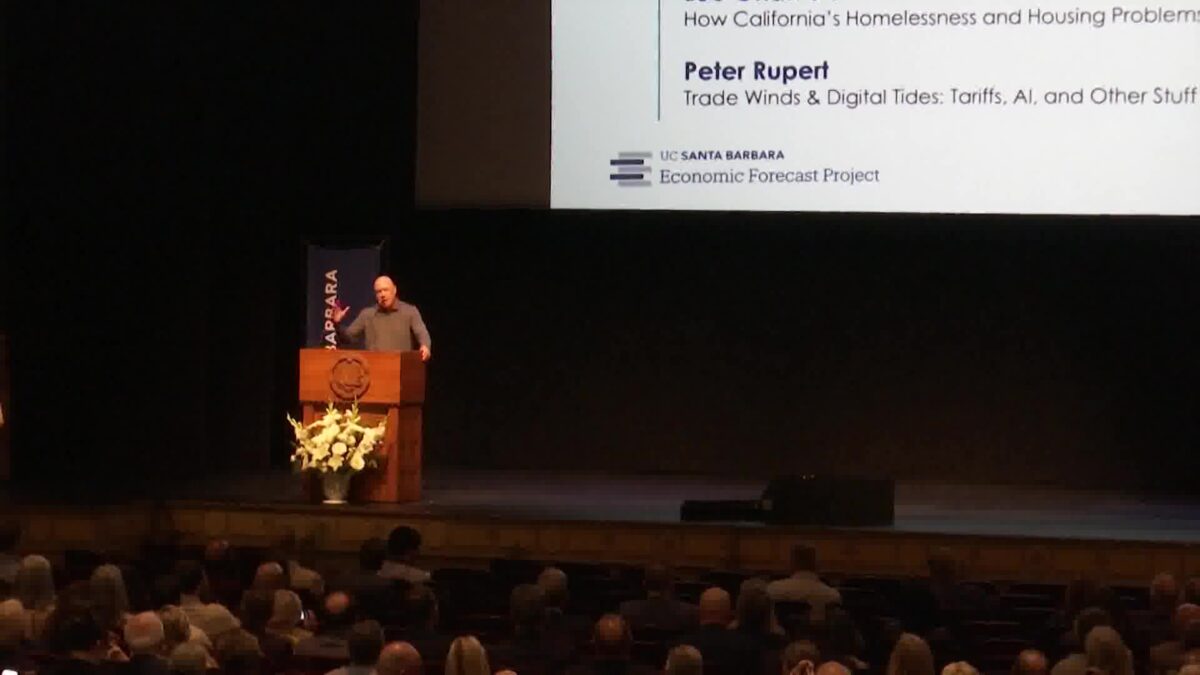California Wine, Tariffs and AI Take Center Stage at UCSB’s 2025 Economic Summit

Tracy Lehr
SANTA BARBARA, Calif. – Business owners, industry leaders, and students cut their work and school days short to attend the 2025 South County Economic Summit at the Granada Theatre on State Street in Santa Barbara.
Ticket holders received an Economic Outlook Publication, a program, and access to a reception featuring California wine, specifically, wine not impacted by tariffs.
This year’s summit featured a lineup of experts speaking on the economic and policy outlook for California and Santa Barbara County.
The Santa Barbara County Economic Report was delivered by Peter Rupert, Director of the UCSB Economic Forecast Project.
Former Federal Reserve President Jim Bullard shared insights from the perspective of a central banker, while UCLA economics professor Lee Ohanian addressed housing issues and potential strategies to reduce homelessness.
University of Rochester economics professor George Alessandria delivered a presentation titled “Trade Policy and the Economy: Past, Present and Future.”
UCSB students volunteered at the event, and some received discounted admission.
Rupert, who quipped that he had “dressed up” for the summit, made a point with his casual attire: Hoka shoes, Ace Rivington jeans, and a Nomad watch—all purchased from local companies.
“These local companies get their products from overseas,” Rupert said, emphasizing how tariffs can impact regional businesses.
Rupert, a critic of tariffs, noted he woke up to news of a temporary deal between the United States and China that boosted the stock market.
“Most economists would say the best tariffs are zero,” he said.
Speakers addressed a record turnout, discussing trade policy, housing, and artificial intelligence. To connect with the audience, they referenced the Smoot-Hawley Tariff Act of 1930, Forrest Gump, Jerry Maguire, and the Laffer Curve as mentioned in Ferris Bueller’s Day Off.
“I think being able to put it in common terms and circumstances we understand puts it into a better light,” said UCSB student and Radius Commercial realtor Jack Gilbert.
Kristen Miller, CEO of the Santa Barbara South Coast Chamber of Commerce, said she gained valuable insight.
“We have been watching tariffs very closely because they do affect local businesses,” said Miller. “So I did learn a lot today about how to maybe try to predict this evening out over time.”
Miller also sits on the board that helped organize the event at the Granada.
Students who volunteered said they were excited to be studying economics.
“I think it’s really important to learn economics and be well-informed,” said UCSB senior Kendall Warner.
“I feel like things are changing so fast, at such a quick pace, that I’m able to learn more,” said UCSB student and intern Aakash Sriram.
Rupert closed his presentation with what he called “the most beautiful picture of all time”—a graph of Gross Domestic Product (GDP).
“This is our real GDP, our real income, our real purchasing power—the amount of stuff we’re able to buy,” he said.
The chart, which resembled a straight line, showed long-term growth.
“This growth number is about 2 percent, something like that,” said Rupert. “Every year, on average, we get 2 percent richer. And what I tell people is, look for what stands out: the Great Depression and World War II—that’s what stands out.”
He said the “little wiggles” in the graph represent different presidential terms and mentioned the recent fluctuations in tariff rates.
“As you can see, they’ve already backed down on a lot of them because we understand what happened during the Great Depression.”
He closed on an encouraging note.
“The beautiful thing is, if we’re left alone, we are a very productive country. We’ve done really well over history. We’re growing faster than Europe right now. So when it comes to tariffs—we’ll be drinking California wine.”
For more information visit https://efp.ucsb.edu